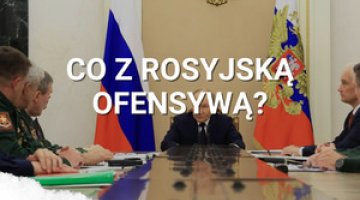Ukrainian forces withdraw from Avdiivka. Day 726 of the war


On 15 February, Ukrainian forces withdrew from fortified areas on the south-western and eastern outskirts of Avdiivka, a process which turned into a retreat the following day under pressure from the attacking Russians. After midnight on 17 February General Oleksandr Syrskyi, the Commander-in-Chief of the Armed Forces of Ukraine, gave the official order to leave the city, and by the end of the day the invaders’ forces had occupied its most important points. By 19 February, the invading forces had occupied the whole of Avdiivka and its surroundings and entered the village of Lastochkyne which lies to the west of it; here they met resistance from the rearguard of the retreating defenders. An unknown number of Ukrainians (probably several hundred soldiers, including members of the elite 3rd Assault Brigade, which had come to the rescue in the previous days to cover the retreat) did not manage to leave the town; they were either captured or are still encircled.
Avdiivka was the main fortified area of the first line of Ukrainian defence in Donetsk oblast, and was probably also the best-defended in the entire system of fortifications built by the defenders in the Donbas. The seizure of the city by the enemy is tantamount to the breakthrough of this line (another line, which is considerably less well fortified, is located 5 to 15 km away) and represents a significant move by Russian forces into the operational space in the western direction. The loss of Avdiivka, like Marinka before it, also has symbolic significance. The first fighting for it took place in 2014, and since then it has been a pillar of the Ukrainian defence north of occupied Donetsk.
On 17 February, the Russians resumed their offensive south of Orikhiv in Zaporizhzhia oblast. Within two days they pushed the defenders out of the areas west and south of the village of Robotyne, which again became a combat area (its recapture in August 2023 marked the apogee of the Ukrainian counter-offensive). To the north-west of Verbove, the invaders regained the forward positions of the first line of defence in Zaporizhzhia oblast (the so-called Surovikin line), which they had lost last summer. Its forces also made further advances south and south-west of Marinka, where they entered Pobieda, as well as in Pervomayske north-west of Donetsk. In addition, they approached Ivanivske west of Bakhmut (according to some sources, clashes for this village have begun), as well as making further advances north-west of Kreminna (they are supposed to be 1–2 km short of the villages of Terny and Yampolivka, which lie on the Zherebets river).
The increased intensity of the invaders’ operations in Zaporizhzhia oblast does not – as some Russian and Ukrainian sources suggest – indicate direct preparation for a new offensive. Rather, they are an attempt to exploit the relative weakness of the Ukrainian army to take back the gains of the counter-offensive of summer 2023. In recent days the Russians have been pushing in five different directions with similar intensity, and we may therefore assume that their main objective continues to be to exhaust the defenders as much as possible, rather than to make rapid advances in the field which run the risk of high losses. It does seem likely, however, that in the perspective of the coming weeks the invaders’ troops will try to go on the offensive in those places where they consider the enemy’s defences to have been most seriously weakened.
On 16 February Kyrylo Budanov, the head of Ukrainian military intelligence (HUR), stated that recapturing the occupied Donbas from enemy hands would be more difficult than seizing Crimea. As he put it, it is necessary to solve two strategic problems to liberate the peninsula: to cut off the land corridor and destroy the Crimean bridge. He added that the poor situation on the front was due to the lack of supply of arms and ammunition (especially 155-mm calibre) and long-range missile systems.

On 15 February, the invaders launched another missile attack on targets deep inside Ukrainian territory. Strikes on energy, transport and industrial infrastructure were reported from the River Dnieper, Lviv, Zaporizhzhia and Khmelnytskyi oblast. In Kyiv and its oblast the damage was said to have been caused by falling debris. The invaders used 26 ballistic and cruise missiles in this attack, of which the defenders claimed to have shot down 13. From the 14th until the morning of the 20th, Russian missiles and kamikaze drones mainly struck the frontline regions of Kharkiv, Donetsk (including Kramatorsk and Slavyansk) and Zaporizhzhia. The Poltava oblast was attacked four times (mainly around Poltava and Myrhorod), and the Kirovohrad oblast was attacked twice (probably the Kanatove airfield near Kropyvnytskyi).
On the night of 20 February, Ukraine was targeted by unmanned drones, whose targets included an industrial facility in Kremenchuk in the Poltava oblast (most likely a refinery), causing a fire. During the period in question, the invaders used a total of 79 missiles, of which Ukrainian forces announced the destruction of 18. According to Ukrainian sources, the Russians did not use any Shaheds between 14 and 17 February, but when it resumed attacks by the morning of 20 February it was said to have used 41 of them. The Ukrainian Air Force Command claimed to have shot down 39 of them, including all 23 used on the night of 20 February.

On 14 February, Ukrainian surface drones sank the landing ship Tsezar Kunikov in the Alupka region of southern Crimea. The attack was said to be the result of another HUR special operation, according to which the vessel was hit by five MAGURA V5 drones. The following day the commander of the Black Sea Fleet, Admiral Viktor Sokolov, was dismissed, probably as a direct result of the loss of the ship. The Tsezar Kunikov is in fact the second Russian vessel to have been sunk in the past two weeks: on 1 February the HUR carried out a similar strike against the small missile corvette Ivanovets.
The Tsezar Kunikov is the third landing ship which the Russians have lost after the Saratov in March 2022 and the Novocherkassk in December 2023 (both fell victim to missile attacks). In addition, two other vessels have been damaged: the Olenegorsky Gorniak in August and the Minsk in September 2023. The Ukrainian Naval Command also lists the Minsk as damaged, but preparations are underway to repair it using elements of the Ukrainian landing ship Kostiantyn Olshansky, which the Russians captured in 2014. For its part, the Olenegorsky Gorniak was taken from Novorossiysk for overhaul in Sevastopol in January. The irretrievable loss of three ships and the at least temporary elimination of two more will significantly weaken the Russian landing potential in the Black Sea, where it currently has eight vessels at its disposal (or just five, as declared by the Ukrainian side).
On 15 February, a kamikaze attack by Ukrainian drones resulted in a fire at a fuel base near Kursk. Two days later, the Ukrainians carried out a massive strike in five Russian regions, using 33 drones (according to Russian sources). An attack on 19 February on a fuel base in Makiivka in the occupied part of Donetsk oblast was said to have been successful.

The 19th Ramstein-format meeting, held on 14 February, reaffirmed its participants’ desire for further military support to Kyiv, but nevertheless did not produce any significant decisions. Canada announced its intention to set aside $44 million to service F-16 fighter jets which will be provided to Ukraine.
Two days later, during Volodymyr Zelensky’s visit to Berlin, Germany announced additional arms and ammunition deliveries worth €1.13 billion: 18 newly produced 155-mm PzH 2000s howitzers (on tracked platforms) and next 18 RCH-155s howitzers (on a wheeled chassis), each to be delivered between 2025 and 2027; two 35-mm Skynex anti-aircraft artillery systems to be delivered in 2025; and 100 missiles for IRIS-T SLS air defence systems and 120,000 122-mm calibre missiles to be delivered this year.
On 16 February, President Zelensky signed further security cooperation agreements with Germany and France (the first such document was concluded with the UK on 19 January). In the agreement, which was signed by Chancellor Olaf Scholz, the German side confirmed it would grant €7.1 billion in financial assistance to Ukraine in 2024. The main areas of long-term military support, through the continued provision of security assistance and modern military equipment, were agreed. The non-military block of cooperation includes not only deepening economic cooperation and financial & technical support, but also measures to shore up the stability of energy & other critical infrastructure, and to strengthen cooperation in the areas of information security and the fight against organised crime. Both sides announced that cooperation and information exchange between their intelligence services would be boosted. Among other things, the document envisages cooperation towards holding Russia accountable for the crime of aggression through the establishment of an appropriate tribunal. Germany will continue to support Ukraine’s EU membership and NATO aspirations.
In an agreement signed on the same day by the presidents of Ukraine and France, it was confirmed that Paris would provide up to €3 billion in military aid to Kyiv in 2024. They made a commitment to continue military cooperation, including the provision of military equipment (especially in the fields of artillery and air defence), but also armoured vehicles, maritime security, support for military medicine, information technology and demining. The French side is to “contribute to the development” of the Ukrainian defence industrial base, in particular through French investments, the localisation of production in Ukraine and the joint production of arms and ammunition. Paris, in cooperation with its other partners, will lend its support to ongoing efforts to use Russian assets to assist Kyiv.
Both the agreements were signed for 10 years and are similar in content. The only specificity is the commitment to financially support Ukraine. The documents are declaratory in nature, and cooperation in specific areas will take place on the basis of more detailed bilateral arrangements. The next countries ready to quickly conclude similar agreements are Denmark, Norway and the Netherlands. On 17 February, President Zelensky announced that an agreement with the US was being worked on, but that it would be signed once Congress had adopted a final decision to continue providing financial assistance to Kyiv.





